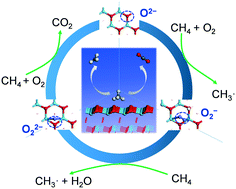Mechanism of selective and complete oxidation in La2O3-catalyzed oxidative coupling of methane†
Abstract
Periodic density functional theory (DFT) calculations were performed to study the evolution of surface oxygen species on a La2O3 catalyst during the oxidative coupling of methane (OCM) reaction, and to establish the catalytic mechanism of the selective and complete oxidation of CH4. The lattice oxygen (O2−) site on the stoichiometric La2O3 surface activates CH4via heterolytic C–H bond cleavage to yield CH3− and H+ fragments, which bind to surface Lewis acid (La3+) and Brønsted base (O2−) sites, respectively. In the presence of the H+ fragment, the CH3− fragment binds quite strongly to the above La2O3 surface, but O2 adsorption facilitates its desorption as a gaseous CH3 radical at relatively low reaction temperatures, while molecular O2 adsorbed at the La3+ site becomes a superoxo radical (O2˙−) species. This O2˙− species reacts with a second CH4 molecule via direct H abstraction to produce another gaseous CH3 radical, accompanied by its transformation into a hydrogenperoxo (HO2−) species, which transfers an O atom to a neighboring O2− site and converts the latter into a peroxo (O22−) site. Whereas CH4 activation at the O2− site is essentially an acid–base reaction, that at the O22− site is clearly a redox reaction, which occurs via an O insertion mechanism to directly form gaseous CH3OH as further confirmed by our ab initio molecular dynamics (AIMD) calculations. CH3OH is further oxidized by an additional O22− site to yield CO2 following a similar mechanism, whereas CO may form from dehydrogenation of the CH2O intermediate at the same site. Thus, the O22− site is proposed to be responsible for complete oxidation of CH4 in the OCM reaction, whereas the O2− and O2˙− sites are responsible for the formation of gaseous CH3 radicals and thus C2 products. Our proposed catalytic mechanism is based on first principles DFT calculations, which gives a comprehensive view of CH4 interaction with the different oxygen species on the La2O3 catalyst surface, and provides critical insights into the possible evolution of surface oxygen species and the detailed surface reaction network.



 Please wait while we load your content...
Please wait while we load your content...